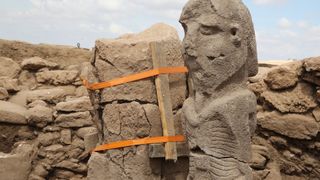11,000-year-old statue of giant man clutching penis unearthed in Turkey
A 7.5-foot-tall statue of a man clutching his penis was unearthed at one of the oldest temple sites in Turkey.

Archaeologists in Turkey have unearthed a nearly 11,000-year-old statue that may depict a giant man clutching his penis, along with a life-size wild boar statue. The two statues come from the neighboring sites of Gobekli Tepe and Karahan Tepe, which are among the oldest temple sites in the world.
The wild boar statue, which is carved from limestone, was found at Gobekli Tepe and dates to between 8700 B.C. and 8200 B.C. It measures 4.4 feet (1.4 meters) long and 2.3 feet (0.7 m) high, the German Archaeological Institute said in a statement. Archaeologists detected red, black and white pigments on its surface, indicating that the sculpture was once painted. Archaeologists unearthed the large sculpture of the manat the site of Karahan Tepe, about 22 miles (35 kilometers) from Gobekli Tepe. It depicts a 7.5-foot-tall (2.3 m) man, according to a translated statement from Turkey's ministry of culture and tourism. The person's ribs, spines and shoulders are particularly pronounced, and the person may actually be depicted as being dead, the statement said.
These discoveries, "represent the latest spectacular finds from these sites which are transforming our understanding of pre-agricultural communities," Benjamin Arbuckle, an anthropology professor at the University of North Carolina at Chapel Hill who was not involved with the excavations, told Live Science in an email.
Researchers also found a small sculpture of a vulture nearby at Karahan Tepe. While archaeologists didn't say how old the newfound statues at, Karahan Tepe are, the site is around 11,000 years old and contains other sculptures and buildings.
Related: The world's oldest temple was built along a grand geometric plan
Archaeologists used to think that the hunter-gatherer communities in southwest Asia around 11,000 years ago "were relatively simple, small in scale, and generally egalitarian," Arbuckle said. But the discoveries at Gobekli Tepe and Karahan Tepe over the last 30 years have disproved this idea, Arbuckle said.
Gobekli Tepe is a sprawling, megalithic site filled with T-shaped pillars and sophisticated sculptures depicting animals, abstract symbols and human hands. The site was likely used in funerary rituals, according to the United Nations Educational, Scientific and Cultural Organization. The presence of such a massive, sophisticated complex suggests that hunter gatherer communities in the region were not as simple as once thought but rather were organized in a way that allowed them to build great works of architecture.
Sign up for the Live Science daily newsletter now
Get the world’s most fascinating discoveries delivered straight to your inbox.
What was the sculptures' purpose?
The purpose of the recently found sculptures is unclear. "The Karahan Tepe finds strike me as the most interesting," Ted Banning, an anthropology professor at the University of Toronto who is not involved with the research, told Live Science in an email. "Any interpretation of the statue is conjectural at this point," Banning said but suggested it was likely that the person shown is dead. It may represent "an important ancestor associated with the building in which it was found."
The figure's pose may give a further clue about its purpose. "The fact that the figure is clutching its penis is also consistent with this interpretation by potentially symbolizing that this person was the progenitor of a social group, such as a lineage or clan, associated with the building," Banning said.
Banning thinks that structures at Karahan Tepe and Gobekli Tepe may have been used as houses rather than temples, "in which case it makes a lot of sense that each would have its own lineage ancestor," Banning said.
It's not surprising that the wild boar sculpture has pigments, he added. "I think it's plausible that much or even most of the sculpture at these sites was originally painted", Banning said, noting that paint doesn't preserve well in the archaeological record.
Archaeologists involved with the excavations did not return requests for comment at time of publication.

Owen Jarus is a regular contributor to Live Science who writes about archaeology and humans' past. He has also written for The Independent (UK), The Canadian Press (CP) and The Associated Press (AP), among others. Owen has a bachelor of arts degree from the University of Toronto and a journalism degree from Ryerson University.
-
Ruth J. Heflin These "scientists" need to stop trying to find the existence of the patriarchy everywhere. Phalluses were magical to our ancient ancestors because they grow as fast as grasses, so males clutching their penises is NOT a symbol of their consciousness of "progenitorhood," as this archeologist WANTS to assume, but a universal sign for the rapid growth of grasses, upon which these people were learning to rely (as verified by many ancient stories, including those of ancient Sumeria and Egypt. Procreation won't be discovered until circa 2400 BCE when Egyptians domesticated swans, the ONLY monogamous animal ever domesticated by humans. Androcentric bias that runs throughout the archeology field must be dismantled because these "scientists" are biased into justifying their world view of the idea that the patriarchy has always existed. They seriously should read my book, Pitiless Bronze: A Postpatriarchal Examination of Prepatriarchal Cultures, so they can learn what the symbols they are uncovering TRULY meant to our ancient ancestors who still viewed women as The Creators, not men. They need to view these finds through the eyes of people who have no idea that both genders are necessary for procreation because their symbolic animals--the wild boar (probably female, not a male) and the vulture were known as excellent mothers.Reply -
soulsoldseparately Replyadmin said:A 7.5-foot-tall statue of a man clutching his penis was unearthed at one of the oldest temple sites in Turkey.
11,000-year-old statue of giant man clutching penis unearthed in Turkey : Read more
As luck would have it, an 11,000-year-old pair of giant boxer briefs was also unearthed, and just a few yards away
Most Popular


